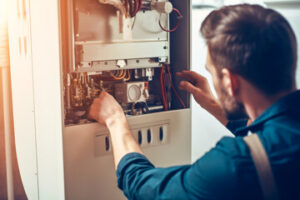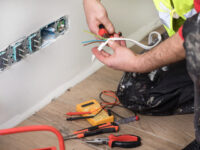Furnace Installation Requires Careful Attention to Details
Furnace Installation requires careful attention to detail. A qualified technician will follow all local and manufacturer requirements to guarantee the proper functioning of the new system.
The technician shuts off gas lines and electrical breakers to create a safe working environment. Then, the ducting system and vent pipes are connected.
The gas line is a vital part of furnace installation, as it supplies fuel to the heating system. During the process, the installer must identify an appropriate route that complies with safety regulations and ensures a steady supply of gas to meet the furnace’s demand. The pipe size must also be appropriate to facilitate the furnace’s operation. Using the wrong size of pipe may result in low gas pressure or improper flow, which can cause serious safety issues.
The installer must also inspect the gas line for leaks and other problems before connecting it to the furnace. This step is crucial, as a malfunctioning gas line can cause unsafe conditions and expensive repairs. To minimize the risk of leaks, the installer should use a pipe wrench with adjustable jaws to grip pipes of various sizes and tighten or loosen fittings. A flaring tool is also important for creating flared ends on copper pipe, which helps achieve a reliable seal when connecting to a fitting.
Another step involves sizing and installing vent pipes to facilitate safe exhaust release. The installer must choose the right sized pipe based on the furnace’s rating, as well as follow local building codes and regulations for venting materials. The installer must also minimize bends and restrictions to ensure smooth airflow.
Properly sizing and installing the ventilation systems can help prevent many of the problems that homeowners experience with their furnaces. For example, if the ductwork is not properly sized, it will limit the amount of air that can move through the system, which can lead to higher utility bills and equipment that wears out more quickly than it should. The installer should also check for signs of worn or damaged components, such as rusted fittings, and address them promptly to reduce the risk of leaks and other problems.
During the process, it is important to make sure that the gas line is clear of combustible materials and has access to a power outlet. It is also important to test the electrical supply with a voltmeter before turning on the furnace. The installer should also install a thermostat for temperature control, and connect the electrical supply to the furnace using color-coded cables.
Ductwork
Ductwork is a big part of the furnace installation process. It can make a significant impact on your home’s airflow and energy efficiency. It is important to have your ductwork examined and cleaned before you install a new furnace. During this time, you can also make any repairs or adjustments needed to the existing ducts and venting.
This includes both the supply duct that brings air to your home and the return duct that returns conditioned air back to the furnace. The supply ductwork must be properly sized to facilitate the flow of air and ensure adequate ventilation. Ductwork also needs to be insulated to reduce heat loss. The ductwork should be insulated using aluminum foil tape and sealed with a flexible duct sealant.
The ductwork itself is typically made from galvanised mild steel or aluminium. These materials are easy to work with and can be cut to size, bent to form different shapes, and assembled to create a duct system that meets the required design. For ducts that are not easily formed, it may be necessary to make a custom-made solution.
It is also important to note that ductwork can be quite expensive. This is why it is important to get a good estimate for the project. Be sure to ask about the equipment manufacturer and model number, the installer’s price breakdown, and expected completion dates. Ensure that the estimate includes mathematical calculations used to size the equipment and is performed by a licensed and certified contractor. This will help you avoid buying undersized or oversized equipment.
When making electrical connections, it is important to follow the instructions in the manufacturer’s manual and local codes. Also, make sure that the voltage is correct. This will prevent any damage to the furnace if there is an imbalance in the power supply.
It is also important to disconnect any items that are connected to the old furnace, including gas lines and ductwork. If these are not disconnected before the new unit is installed, it could cause a fire hazard. Be sure to clear the area surrounding the new furnace, and remove any combustible materials that could ignite from the exhaust gases.
Vent pipes
Furnace vent pipes play a vital role in eliminating harmful combustion gases, including carbon monoxide, from your home. They also play a major part in ensuring optimal furnace performance by allowing the system to intake sufficient air for combustion. These functions contribute to lowering your energy bills and preserving a comfortable indoor climate for your family.
Most furnaces are equipped with a metal exhaust vent pipe, called a flue pipe, that directs the hot combustion gases to the outside through a chimney or other venting system. The pipe is typically made of corrosion-resistant steel. If your furnace is older, it probably has a metal exhaust vent pipe with a single wall, while newer gas furnaces are equipped with double-wall metal pipes that have an outer layer of insulation to reduce heat transfer and make the system more efficient.
The type of gas you use for heating your home will affect which kind of pipe you have to install for venting purposes. Generally, gas furnaces with a low efficiency rating will require the use of steel vent piping while high-efficiency “condensing” furnaces can be vented with PVC piping. It’s important that the ventilation pipes are sized appropriately to match your furnace and installed according to the manufacturer’s guidelines. If you’re unsure about which size pipes to use, consult an experienced HVAC professional to ensure proper venting.
During furnace installation, make sure your contractor carefully inspects the condition of all vent pipes. They should be free of blockages, obstructions, or other issues that could lead to poor ventilation and unsafe conditions for your family. Having these issues dealt with promptly can help prevent costly repairs and maintenance work for your system in the future. For example, if the condensate drains aren’t properly drained, it can result in moisture and mold buildup, which will impact the performance of your gas furnace. It’s important to have this issue taken care of immediately, and a professional technician can clean the drain and properly seal the pipes to prevent moisture from getting into the flue gases. They can also check the vents for signs of a backdraft, which is a dangerous situation and requires immediate attention.
Insulation
After all the electrical connections are made and power is supplied, the furnace must be tested to make sure it works properly. This is done by adjusting the thermostat and observing how it responds. Any malfunctions during testing will allow technicians to take corrective measures. It is also important to double-check all electrical connections and that they are properly fastened. If they are not, the furnace could suffer from electrical shocks and pose a fire hazard.
Before beginning the installation, it is essential to read through the manufacturer’s manual and understand what needs to be done during the process. The manual will provide a step-by-step guide to installing the furnace. A good place to start is by clearing the area where the furnace will be installed, ensuring that it is free of any combustible materials and that the space is adequately ventilated.
The space must be clean and dry to avoid damage or electrical issues. It is also important to remove any items that could be easily caught on fire from the area, such as paint cans, wood scraps and gasoline. It is also crucial to clear out ductwork and ensure that they are not blocked, so that air can circulate correctly.
It is vital to choose properly sized vent pipes according to the manufacturer’s recommendations for the specific furnace model. Improperly sized pipes can cause inadequate ventilation or backpressure that will affect efficiency and safety. It is also advisable to use PVC pipes as they are highly durable and meet local building codes. It is also important to minimize the number of bends or restrictions in a pipe run and to use duct tape or sealant to prevent leakage.
A condensate drain line must be connected to the bottom of the furnace and routed towards a drainage point. This line removes excess water from the system to avoid overheating and moisture problems. It is important to make sure the line has a slight slope that will facilitate proper drainage.
Finally, it is a good idea to install a carbon monoxide detector to protect your family from harmful gases produced by the malfunctioning furnace. This is a cheap and easy way to add a layer of protection against potential tragedies.





